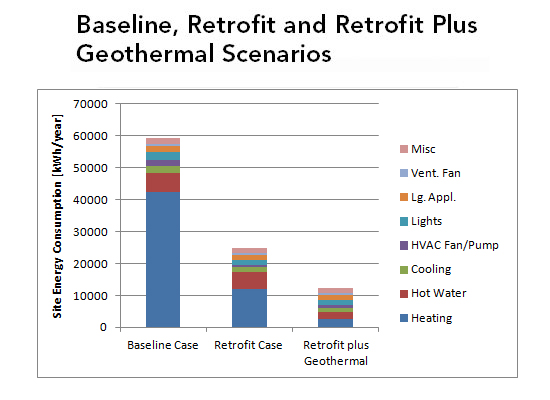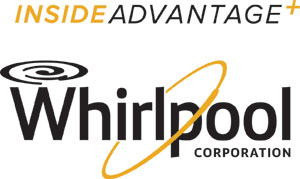Residential Retrofits Achieve Net-Zero Energy
Achieving Net-Zero Energy
The net-zero energy goal was achieved for the test house by converting all end use devices to a 100-percent electric system and installing on-site renewable energy generation equipment to satisfy the amount of electrical energy consumed by the house over the course of the year. Natural gas could not be considered as it is not a renewable resource and it cannot be produced on site, so the entire heating and cooling system as well as the water heater (furnace and boiler, respectively) had to be replaced by electrically driven systems.
Modeling was again employed in this stage, with the same software used to complete another simulation to evaluate the total energy consumption of the test house post retrofit, including the effect of a geothermal heat pump. All other inputs remained the same as in the optimum retrofit case scenario. Not surprisingly, total site energy usage was lower than without a geothermal system, on the order of 12,424 kWh/year versus 24,855 kWh/year—an achievement that resulted from the heat pump's high coefficient of performance (COP). The COP of a heat pump is a ratio of heating or cooling provided to electrical energy consumed. Higher COPs mean lower operating costs.
The annual site energy consumed by the geothermal heat pump to cover the heating and cooling demand is 4,080 kWh—that contrasts favorably with the retrofit case which required 13,387 kWh/year for the natural gas energy required for the furnace for heating and the electricity required for the air conditioner. In short, the use of a geothermal heat pump was able to deliver a further HVAC system savings of 9,307 kWh/year on top of the retrofit simulation which focused on the envelope, appliances, and lighting.

For the main renewable energy system, researchers selected a solar photovoltaic system that will be placed on the roof to generate electricity. While the actual sizing of the solar system was outside the researchers' scope, online software PVWatts was utilized to arrive at some basic conclusions. Analysis parameters were the solar irradiance in West Lafayette and the test house roof pitch of 25°; however, the model did not consider shading. The simulation was conducted to place the solar system in the exact configuration of test house roof, with 1.33 kWp installed on the south side—a position that corresponds to the total available space there—and 10 kWp on the west side. Results showed that it is possible to have a total electricity production from this system configuration of 12,313 kWh/year. From researchers' experience, the online software can “under predict” actual solar array production and it is believed that a 11.3 kWp system, or even smaller, is more than enough to fulfill the net-zero energy requirement for the ReNEWW House.
Net-Zero Energy In Older Homes
With rising energy costs and global warming concerns, energy efficiency is crucial. The existing housing stock in the United States, much of which was constructed prior to the time when energy-efficient construction was envisioned much less implemented, represents a sizeable source of energy savings through retrofits combined with on-site renewable energy. Through the ReNEWW House in Indiana, Purdue University and its industry partners have demonstrated the ability of older homes to achieve retrofitted net-zero energy status. Using a simulation model whose baseline prediction was within 10 percent of actual consumption, researchers used an optimization tool to select the best retrofit actions, demonstrating that 50 percent of energy savings can be obtained. The model further showed that the net-zero energy goal can be achieved for the test house by replacing the HVAC system with a geothermal heat pump, generating hot water with an air source heat pump hot water heater, and installing a 11.3 kWp solar photovoltaic system.
The ReNEWW House is both a valuable research lab and a sustainable living showcase dedicated to highlighting technologies which are at market or just coming to market—some of which might be applicable in retrofit scenarios and others which may be more appropriate for new construction. As such, it provides useful insight for millions of Americans as a way to not only reduce their own utility bills but to contribute to the worldwide effort to reduce energy use, reduce the emission of greenhouse gases, and put an end to climate change.
Endnotes
1. Buildings Energy Databook 2011
4. Energy Simulation and Optimized Retrofit Practices Applied to a Real Dwelling, Giulia MARINELLO1*, Stephen L. CASKEY1, Eric J. BOWLER2, Eckhard A. GROLL1, Purdue University, School of Mechanical Engineering, Ray W. Herrick Laboratories
5. http://www.resnet.us/hers-index-score-card
6. http://energy.gov/public-services/homes/saving-electricity/appliances-electronics
7. http://www.greenbuildingadvisor.com/blogs/dept/musings/energy-modeling-isn-t-very-accurate
8. http://energy.gov/energysaver/articles/geothermal-heat-pumps
 | Whirlpool Corporation, the leading manufacturer of major home appliances, brings you Inside Advantage®—innovative products providing efficiency and performance; market insights helping you to create more appealing designs; and targeted services that make doing business with them easier and more profitable. www.insideadvantage.com |








